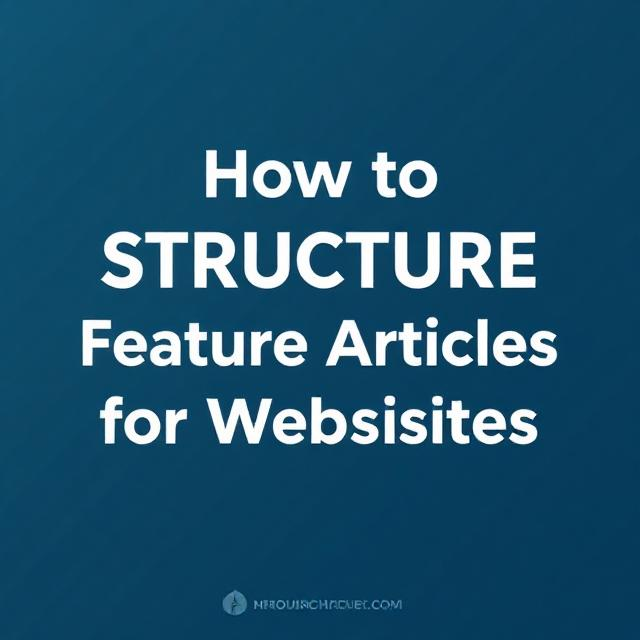
Feature articles for websites are an engaging form of online content that blends information, storytelling, and a unique perspective to captivate readers. To make them effective, you must balance creativity with structure to ensure they inform, entertain, and provide value. Here’s a guide on how to properly structure feature articles for websites.
1. Understanding the Goal of a Feature Article
Before diving into structure, it’s crucial to understand what a feature article aims to achieve. Unlike news articles, which focus on delivering facts quickly, feature articles explore topics in depth. They can be opinion pieces, human-interest stories, how-to guides, or profile articles. The key is to focus on storytelling and providing a fresh angle on a topic.
2. The Ideal Structure for a Feature Article
A well-structured feature article is divided into several sections:
1. Headline
The headline is the first thing readers see, and it must grab their attention immediately. It should be concise, catchy, and relevant to the topic. A strong headline promises value and encourages the reader to click.
Tips for writing a great headline:
- Use action words and power phrases.
- Incorporate numbers, questions, or emotional triggers.
- Make it SEO-friendly by including relevant keywords.
2. Introduction (The Lead)
The introduction sets the tone for the article and hooks the reader. It can start with a surprising fact, a question, an anecdote, or a powerful statement. Your goal is to create curiosity and entice the reader to continue. Keep it short but impactful.
Elements of a strong lead:
- Introduce the main idea without giving everything away.
- Reflect the tone of the piece—whether it’s serious, humorous, or informative.
- Avoid clichés and generic openings.
3. The Body
The body of the article is where you deliver the bulk of your content. It should be logically organized and easy to follow. Divide the body into subsections using subheadings to break up the text and improve readability.
Key aspects of a well-structured body:
- Use a chronological, thematic, or problem-solution structure depending on the topic.
- Provide evidence, examples, quotes, and research to back up your points.
- Keep paragraphs short (3-4 sentences) for better online readability.
- Use bullet points or numbered lists where appropriate.
Subheadings should be informative and guide the reader through the article. They also help improve SEO.
4. Visuals and Media
Incorporate images, videos, infographics, and other visual elements to enhance the article. These break up large blocks of text, making the piece more engaging and easier to read. Visuals also help convey complex information more effectively.
Best practices for visuals:
- Use high-quality, relevant images.
- Ensure your visuals are optimized for web loading speed.
- Add captions to explain or provide context.
5. Conclusion
The conclusion ties everything together and leaves a lasting impression on the reader. It can summarize the main points, provide a call to action (CTA), or offer something for the reader to reflect on.
Effective conclusion techniques:
- Restate the article’s purpose or main takeaway.
- Suggest next steps, such as further reading or actionable advice.
- Avoid introducing new information.
3. Optimizing Your Feature Article for the Web
Writing for the web requires special considerations to ensure your content is accessible and optimized for search engines.
SEO (Search Engine Optimization)
Incorporating SEO best practices will help your article rank higher in search results, increasing its visibility. Use keywords naturally, optimize meta descriptions, and include internal and external links.
Checklist for SEO:
- Use primary and secondary keywords in headings, subheadings, and body text.
- Optimize images with alt text.
- Ensure your article is mobile-friendly.
Readability and Formatting
Online readers tend to skim rather than read every word. Formatting your article for readability will improve user engagement and reduce bounce rates.
Readability tips:
- Use short sentences and avoid jargon.
- Add whitespace for better readability.
- Use bold or italic text to emphasize important points.
4. Editing and Proofreading
Once the article is written, take the time to edit and proofread thoroughly. This step ensures your content is error-free, coherent, and polished.
Editing checklist:
- Check for grammar, spelling, and punctuation errors.
- Ensure the article flows smoothly from one section to the next.
- Verify facts, statistics, and quotes.
- Remove unnecessary words or repetitive phrases.
A well-structured feature article for a website is informative, engaging, and easy to read. By following a clear structure—headline, introduction, body, visuals, and conclusion—you can create content that resonates with your audience and achieves its purpose. Don’t forget to optimize for SEO and readability to maximize the article’s reach and impact.
With practice and attention to detail, you’ll be able to produce feature articles that not only capture readers’ attention but also keep them coming back for more.

